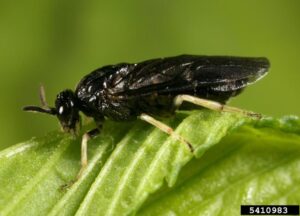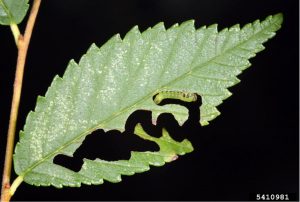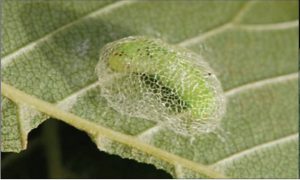The elm zigzag sawfly (EZS), Aproceros leucopoda, is a non-native insect recently detected in several midwestern states. Originally from eastern Asia, this insect is rarely considered a problem in its native range, having several natural enemies and environmental factors able to keep it in check. However, when in new landscapes, aspects of this insect’s life cycle enhance its ability to spread across new habitats and do significant damage to its host plant, the elm tree. EZS was first detected outside of its native range in Europe in 2003. Then, in 2020, it was found in North America for the first time in Quebec. It has since been detected in several states in the US, spreading first through the Northeast before entering the Midwest. It has not yet been detected in Indiana, but has been in the surrounding area.
- Figure 1. Elm zigzag sawfly adult, Gyorgy Csoka, Hungary Forest Research Institute, Bugwood.org
Elm zigzag sawfly is a member of the insect order Hymenoptera, which includes bees, ants, and wasps. More specifically, sawflies belong to a suborder known as Symphyta, whose members are noted for a broad-waisted appearance and a saw-shaped ovipositor. Sawflies are a fairly common group of insects, though observers will often overlook them or confuse them for other insects. Adult EZS are generally small, darkly-colored insects that are easy to write off as ‘just another black bug’ you see around the garden or yard (Fig. 1). They resemble wasps, but possess a broad waist with no narrowing of space between the thorax and abdomen, and they lack a stinger. EZS larvae closely resemble caterpillars in both form and feeding habits, with pale green coloration, a black stripe that runs down the length of the body, and dark T-shaped markings on the legs (Fig. 2). The larvae, like moth and butterfly caterpillars, will also possess six pairs of fleshy prolegs that are lost upon reaching maturity. While the larvae bear chewing mouthparts to consume the leaf material of many kinds of plants, the adults are nectar and pollen-feeding. It should be noted that EZS larvae chew zigzag patterns into elm leaves, thus the common name of the insect. Like bees and wasps, sawflies also possess wings, but are typically lazy fliers, choosing to fly only during warm, sunnier periods of the day.
- Figure 2. Elm zigzag sawfly larva feeding, Gyorgy Csoka, Hungary Forest Research Institute, Bugwood.org
Life Cycle
Elm zigzag sawfly goes through complete metamorphosis with 4 distinct life stages: egg, larva, pupa, and adult. At the start of spring, adult EZS will begin to emerge from cocoons after overwintering as a pupa. The adults will feed, mate, and lay eggs for the remainder of their life, which is only six to seven days. Adult females are capable of laying up to 60 eggs within her lifetime, but that number appears to be highly variable, with oviposition numbers sometimes in the single digits. The eggs of EZS are tiny, between 0.8 and 1.0 mm, and are normally laid along the margins of leaves. The eggs start blue-green in color, eventually turning black as the nascent larva gets close to emerging. Once mobile, EZS larvae will develop through six instars over the course of 15-18 days, depending on environmental conditions. Larvae will then form a net-like cocoon attached to available surfaces (Fig. 3), which may include leaves, stems, even nearby walls and fence posts. If the larvae are pupating as colder temperatures approach, they move into leaf litter to overwinter. Otherwise, expect pupation to take roughly 10 days before an adult emerges.
- Figure 3. Elm zigzag sawfly cocoon, Danail, Doychev, University of Forestry, Bulgaria
Many sawfly species, including EZS, are parthenogenetic and use asexual reproduction to create the next generation. Parthenogenetic reproduction is when a species only produces females, and all offspring are daughter-clones of their mother. Since reproduction does not require a male insect, eggs laid by EZS are unfertilized, but remain viable. Given the time from oviposition to adulthood, this means multiple generations per year become very easy to accomplish and takes less energy; there’s no need to search for or attract a mate, so more energy can be dedicated to egg production. When placed in a landscape outside of its native range, asexual reproduction gives EZS a distinct advantage in population development. In Europe, EZS can have between four and six generations in a single season, while in North America, it appears to have a maximum of two generations. This difference could be driven by environmental differences and host plant availability between the two locations, but little is known about EZS reproduction and ecology in North America.
Host Plants & Damage
As the name indicates, elm zigzag sawfly only feeds on elms (Ulnus spp.). However, they show a broad range of choice among elm species, including American, Chinese, English, Siberian, winged elm, and several hybrids of these species. Since American elms were nearly wiped out during the Dutch elm disease outbreak in 1928, many elms in North America are non-native or hybrids of cultivars intended to resist the disease. In areas where EZS has been reported in North America, there has not yet been any evidence that the insect will discriminate between any of these species.
Elm zigzag sawfly is a defoliator, and the direct damage they do is limited to the leaves of an elm tree. The damage is caused by larval feeding activity; as mentioned above, the adults feed on nectar and pollen and cause no damage to their hosts. Young larvae will consume leaf material in a zigzag pattern, thus the common name. However, as the larvae age and get bigger, they lose the tendency to form zigzags and focus more on consuming as much soft material as they can. Larvae will avoid consuming the tougher material of the leaf veins, resulting in a ‘skeletonized’ appearance in damaged elm leaves. While most trees will survive defoliation, years of feeding by EZS will weaken a tree and increase its susceptibility to other pests and disease. There has also been some evidence of EZS outcompeting native moth and butterfly species in Europe, however, this remains to be seen for those invading North America.
Management
Since EZS has only recently arrived in North America, there are few management recommendations. While the insect has natural enemies and parasitoids in its native range, those organisms are not successful at population control. In Europe, some insecticides have been effective at controlling the insects, but most treatments are targeted at individual trees or stands. Also, even with insecticidal treatments, reinfestation is likely, and treatment will need to be done year after year.
The best management practice for elm zigzag sawfly, at least for the time being, is prevention. Monitor elm trees for the presence of the insect by checking leaves for zigzag patterns. Throughout the season, you can also search for net-like cocoons on the surface of leaves, trees, walls, or other surfaces. As with all invasive tree pests, it cannot be stressed enough that firewood should not be moved. The risk of transmitting pupating EZS across areas through firewood is high, and due to the short amount of between generations, transmission can occur any time during the warm season.
The distribution of elm zigzag sawfly in North America is still being mapped out, making reporting a high priority. While this insect has not yet been seen in Indiana, it has in several nearby states, putting us at high risk for invasion. By reporting this insect to the Indiana Department of Natural Resources, early action can be taken to quarantine and research this insect so entomologists can quickly gain an understanding of its ecology in the Hoosier state. You can easily report sightings by calling 1-866-NOEXOTIC, a hotline set up by Indiana DNR for that purpose. You can also send in samples to the Purdue Plant & Pest Diagnostic Lab for identification. Visit their website (https://ag.purdue.edu/department/btny/ppdl/index.html) to learn how you can submit samples, either physical or digital.
There is still a lot to learn about elm zigzag sawfly and its ecology in North America. By being vigilant and reporting sightings of this insect, regulatory and research organizations can learn more and create effective plans for preventing the spread of EZS in our state. If you are unsure how to get started, check out our website (ag.purdue.edu/reportinvasive/) or feel free to reach out to Bob Bruner, Exotic Forest Pest Educator, by emailing rfbruner@purdue.edu!


